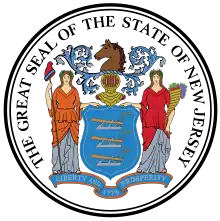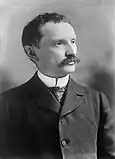| |||||||||||||||||||||
| |||||||||||||||||||||
 County results Fielder: 30–40% 40–50% 50–60% 60–70% Stokes: 30–40% 40–50% 50–60% 60–70% | |||||||||||||||||||||
| |||||||||||||||||||||
| Elections in New Jersey |
|---|
 |
The 1913 New Jersey gubernatorial election was held on November 4, 1913. Democratic acting Governor James Fairman Fielder, who resigned a week before the election so that he could succeed himself, defeated Republican former Governor Edward C. Stokes and Progressive former State Senator Everett Colby.
The state's first-ever direct primary elections for governor were held on September 23,[1] though the contests were largely uneventful. For the Democratic nomination, Fielder defeated former Trenton mayor Frank S. Katzenbach, making his third run for governor. Stokes easily topped a four-man field in the Republican Party, including former U.S. Representative Charles N. Fowler, whom he had defeated in the 1910 primary for U.S. Senate. The Progressive primary was closest, with Colby defeating Montclair industrialist Edmund Burke Osborne by 29 percent of the vote.
Democratic primary
Candidates
- James Fairman Fielder, State Senator for Hudson County, President of the New Jersey Senate, and acting Governor[2]
- Frank S. Katzenbach, former mayor of Trenton and candidate for governor in 1907 and 1910[3]
Withdrew
- H. Otto Wittpenn, mayor of Jersey City[3]
Candidates
The Democratic nomination was hotly contested between two progressive candidates from Hudson County, acting Governor James Fairman Fielder and H. Otto Wittpenn, the mayor of Jersey City. Fielder prevailed by securing the endorsement of President (and former Governor) Woodrow Wilson on July 23, when President Wilson called on Wittpenn to unite the party behind Fielder, who had "backed [Wilson] so consistently, so intelligently, so frankly and honestly throughout my administration ... that I feel I would have no ground whatever upon which to oppose his candidacy."[4] Wittpenn acquiesced and withdrew from the race.
Fielder, who thus had the support of Wilson and the party machine, easily defeated third-time candidate Frank S. Katzenbach in the September 23 primary.[4]
Results
| Party | Candidate | Votes | % | |
|---|---|---|---|---|
| Democratic | James Fairman Fielder (incumbent) | 80,414 | 69.61% | |
| Democratic | Frank S. Katzenbach | 35,115 | 30.39% | |
| Total votes | 115,529 | 100.00% | ||
Republican primary
Candidates
- Robert Carey, former Jersey City judge[2]
- Charles N. Fowler, former U.S. Representative from Elizabeth and candidate for U.S. Senate in 1910[2][5]
- Carlton B. Pierce, State Senator from Union County[2]
- Edward C. Stokes, former Governor of New Jersey and candidate for U.S. Senate in 1910[2]
Campaign
Former U.S. Representative Charles N. Fowler ran on a progressive platform favoring a convention to redraw the state constitution and various electoral reforms, including the recall of all officers except judges, initiative, referendum, and making failure to vote in a primary a bar to voting in the general election.[5]
Results
| Party | Candidate | Votes | % | |
|---|---|---|---|---|
| Republican | Edward C. Stokes | 60,644 | 70.05% | |
| Republican | Charles N. Fowler | 10,571 | 12.21% | |
| Republican | Robert Carey | 10,336 | 11.92% | |
| Republican | Carlton B. Pierce | 5,022 | 5.80% | |
| Total votes | 86,573 | 100.00% | ||
Progressive primary
Candidates
- Everett Colby, former State Senator from Essex County
- Edmund Burke Osborne, Montclair art calendar industrialist[6]
Campaign
On July 26, both candidates spoke in Ocean Grove at a mass meeting of the New Jersey Men's League for Women's Suffrage, along with George La Monte, Lillian Feickert, and Mina Van Winkle.[7]
Osborne originally requested that Colby tour the state with him, since both candidates were from Essex County, but Colby declined before acquiescing to a debate in Montclair on September 11. The debate was moved to Newark's Kreuger Auditorium at Osborne's request to accommodate a larger audience.[8]
Results
| Party | Candidate | Votes | % | |
|---|---|---|---|---|
| Progressive | Everett Colby | 6,458 | 63.91% | |
| Progressive | Edmund Burke Osborne | 3,647 | 36.09% | |
| Total votes | 10,105 | 100.00% | ||
General election
Candidates
- John C. Butterworth (Socialist Labor)
- Everett Colby, former State Senator for Essex County (Progressive)
- Daniel F. Dwyer (Independent)
- James Fairman Fielder, State Senator for Middlesex County, President of the New Jersey Senate, and acting Governor (Democratic)
- James G. Mason (Prohibition)
- Edward C. Stokes, former Governor of New Jersey (Republican)
- James M. Reilly (Socialist)
Results
| Party | Candidate | Votes | % | ±% | |
|---|---|---|---|---|---|
| Democratic | James Fairman Fielder | 173,148 | 46.13% | ||
| Republican | Edward C. Stokes | 140,298 | 37.38% | ||
| Progressive | Everett Colby | 41,132 | 10.96% | ||
| Socialist | James M. Reilly | 13,977 | 3.72% | ||
| Prohibition | James G. Mason | 3,427 | 0.91% | ||
| Socialist Labor | John C. Butterworth | 2,460 | 0.66% | ||
| Independent | Daniel F. Dwyer | 875 | 0.23% | ||
| Majority | |||||
| Turnout | |||||
| Democratic hold | Swing | ||||
References
- 1 2 3 4 "Manual of the Legislature of New Jersey". M.R. Dennis & Co. 1914: 194.
{{cite journal}}: Cite journal requires|journal=(help) - 1 2 3 4 5 "HEAR 7 CANDIDATES FOR GOVERNORSHIP: Men Seeking Jersey Executive Office Meet on One Platform in Newark". The New York Times. September 5, 1913. p. 10. Retrieved July 12, 2022.
- 1 2 "KATZENBACH A CANDIDATE: Ex-Mayor of Trenton Wants to Be Governor of New Jersey". The New York Times. February 12, 1913. p. 24. Retrieved July 12, 2022.
- 1 2 Biography of James Fairman Fielder (PDF), New Jersey State Library
- 1 2 "HERE'S FOWLER'S PLATFORM". The New York Times. May 30, 1913. p. 7. Retrieved July 12, 2022.
- ↑ Cupper, Dan (2003). "A Working Partner: The Osborne Company". Crossroads of Commerce: The Pennsylvania Railroad Calendar Art of Grif Teller. pp. 44–56. ISBN 9780811729031.
- ↑ "NEW JERSEY MEN'S LEAGUE FOR WOMEN SUFFRAGE MASS MEETING AT THE OCEAN GROVE AUDITORIUM". Asbury Park Press. July 25, 1913. p. 9. Retrieved July 12, 2022.
- ↑ "Debate Lost to Montclair". The Montclair Times. September 6, 1913. p. 12. Retrieved July 12, 2022.
- ↑ Kalb, Deborah (December 24, 2015). Guide to U.S. Elections. ISBN 9781483380353. Retrieved January 25, 2016.


.jpg.webp)